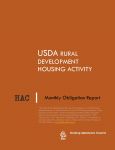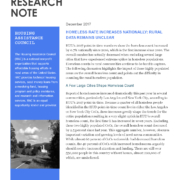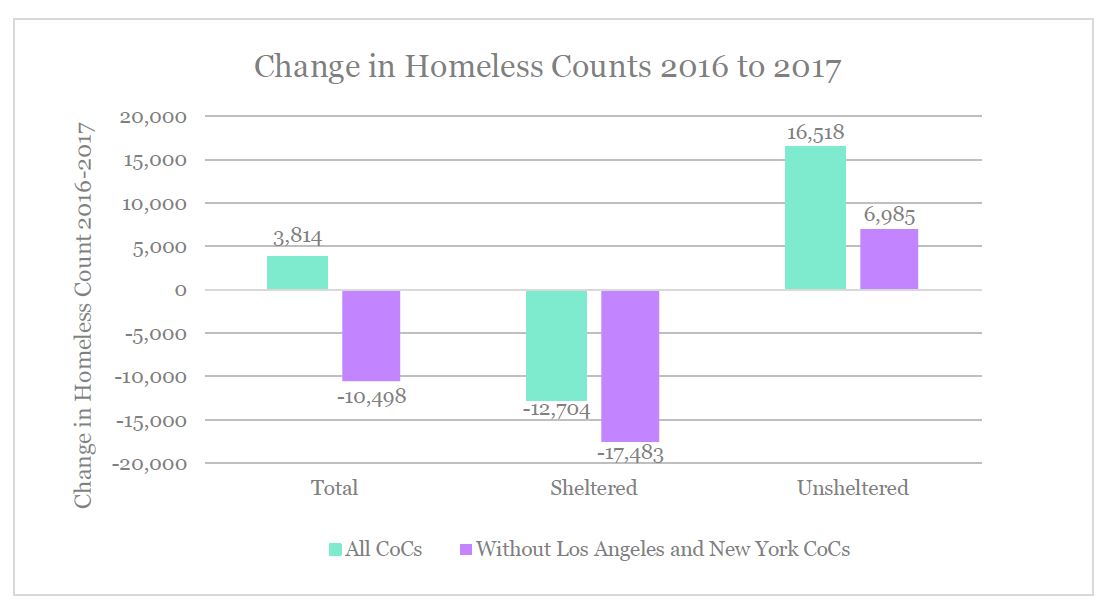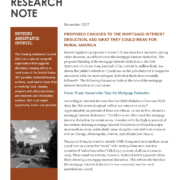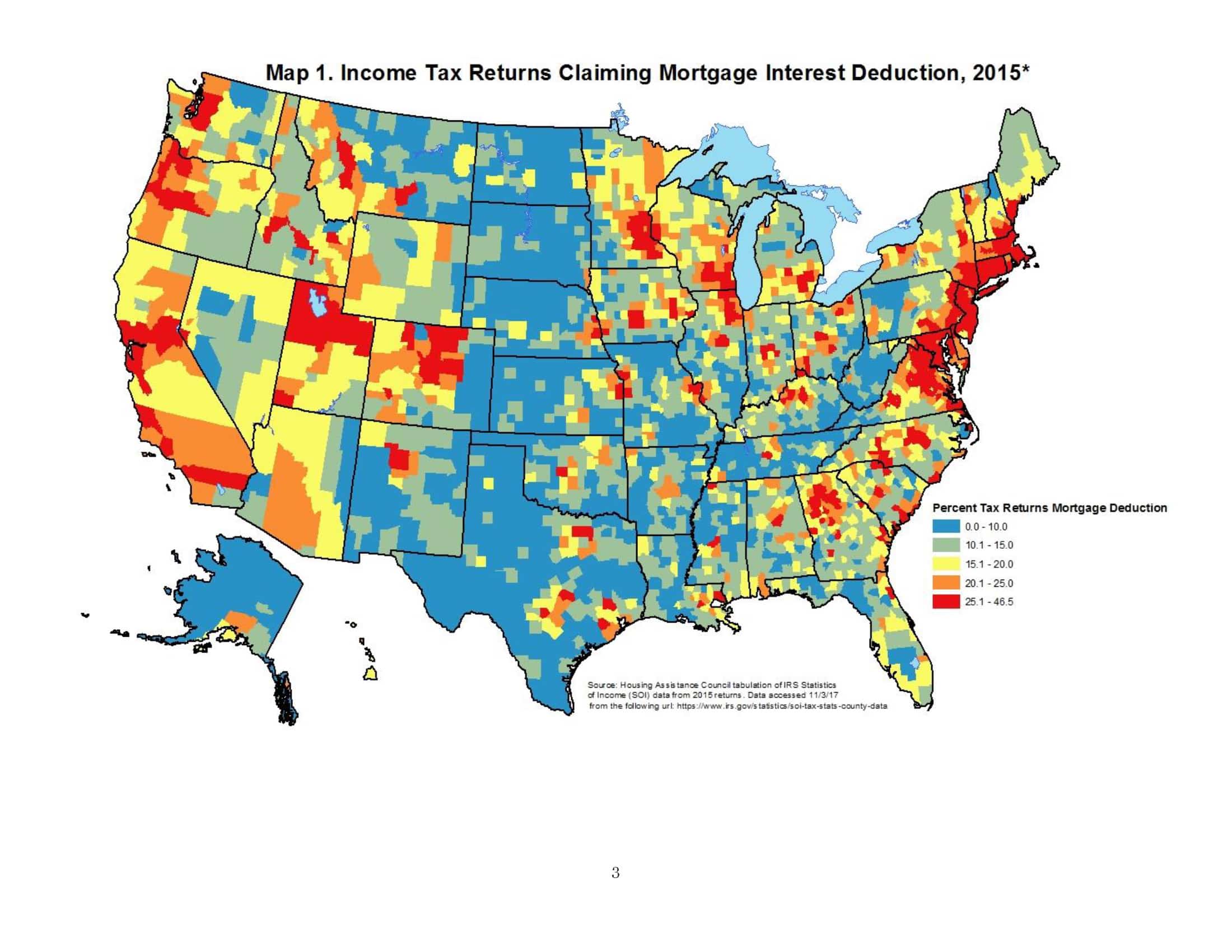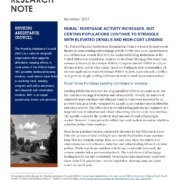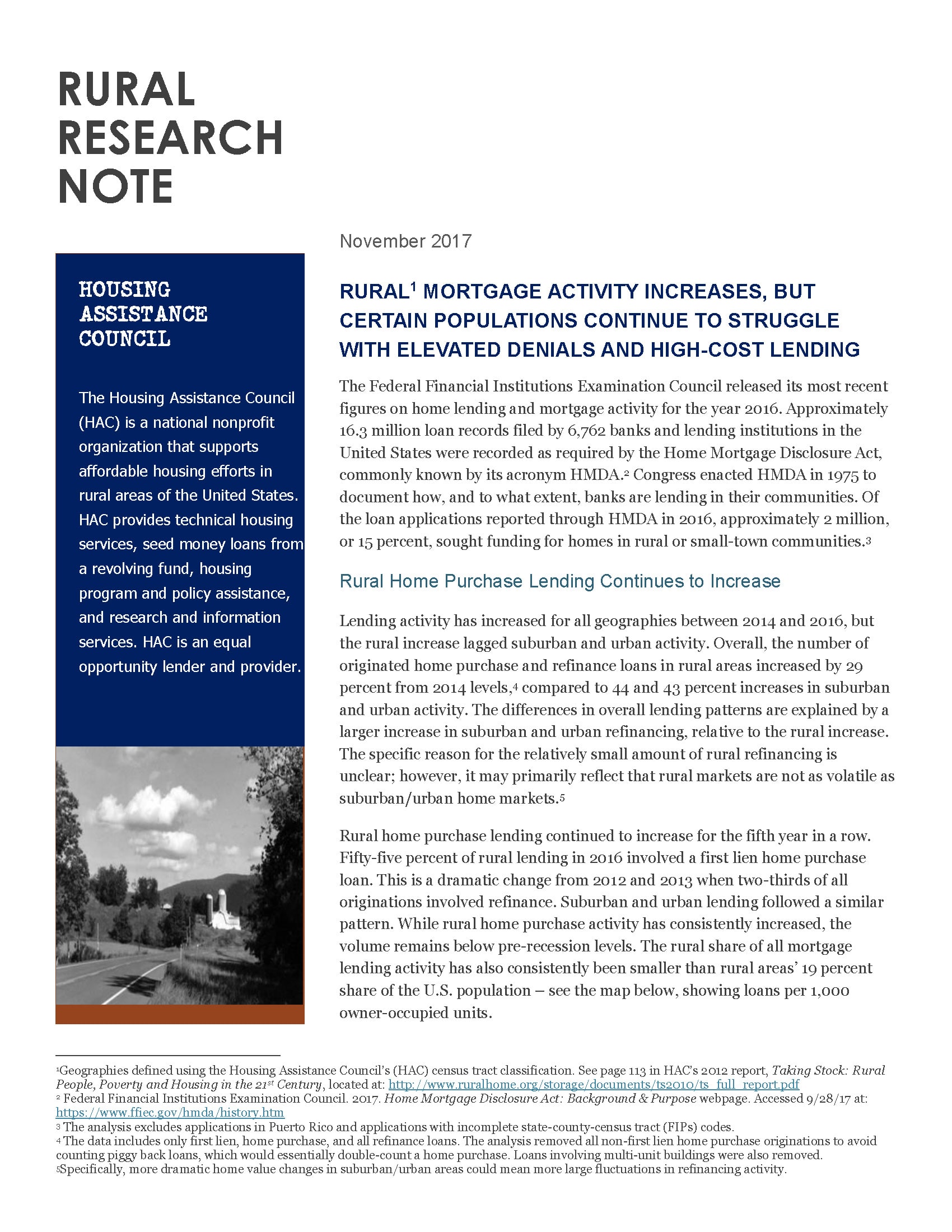HAC News Formats. pdf
January 18, 2018
Vol. 47, No. 2
Government shutdown or another CR are both possibilities • Rural Prosperity Task Force report issued • Trump signs Executive Order on rural broadband, House members introduce bills • HUD suspends fair housing rule, requests comments • House passes expansion of Family Self-Sufficiency program • Guidance offered on using Section 538 for Section 515 preservation • RD updates information on Capital Needs Assessment for rental properties • USDA RD single-family loan limits revised for some states • Affordable housing linked to opioid addiction recovery • Interactive map shows debt by county • MacArthur explains why educators, health professionals, and those focused on economic mobility should care about housing • HUD offers Secretary’s Award for Healthy Homes • Shonterria Charleston named HAC’s Director of Training and Technical Assistance • Three webinars offered on financing Farm Labor Housing with USDA Section 514/516 funding • HUD sets webinar on Manufactured Home Dispute Resolution Program
HAC News Formats. pdf
January 18, 2018
Vol. 47, No. 2
Government shutdown or another CR are both possibilities.
At press time, Congress is considering a continuing resolution that would fund federal programs through February 16, replacing the CR that expires January 19. It is also still possible the new CR will fail – leading to a shutdown of most of the federal government – because it does not include provisions such as protection for young immigrants in the Deferred Action for Childhood Arrivals program.
Rural Prosperity Task Force report issued.
USDA Secretary Sonny Perdue presented the report from the Task Force on Agriculture and Rural Prosperity (see HAC News, 1/4/18) to President Trump on January 8. Affordable housing is included among several “quality of life” factors; the other sections of the report cover e-connectivity, the rural workforce, technological innovation, and the rural economy. The document notes the increase of rural housing affordability issues, especially for renters. Its recommendations are general, including developing a set of best practices, taking action on all levels of government, and incentivizing private sector resources in workforce housing. In the rural workforce section, the report recommends improving the H-2A visa program to “ensure that farmers have access to the lawful workforce that is needed.” HAC’s summary of the report is posted online.
Trump signs Executive Order on rural broadband, House members introduce bills.
On January 8, President Trump issued a Presidential Memorandum instructing the Department of Interior to allow rural broadband installation on federal property and an Executive Order requiring agencies to use standardized forms and contracts in order to streamline the process for these installations. Members of the House Subcommittee on Communications and Technology have introduced the first of a series of bills that would reduce regulatory barriers to expansion of rural broadband infrastructure.
HUD suspends fair housing rule, requests comments. Jurisdictions that must prepare Consolidated Plans in order to receive HUD funding will not be required to produce Assessments of Fair Housing until 2020 at the earliest, HUD has announced. They will still be obligated to affirmatively further fair housing, using the Analyses of Impediments that will eventually be replaced by the AFH. HUD has posted answers to Frequently Asked Questions. Comments are due March 6. For more information, contact Krista Mills, HUD, 202-402-6577.
House passes expansion of Family Self-Sufficiency program.
On January 17 the full House approved H.R. 4258, the Family Self-Sufficiency Act, which permanently reauthorizes HUD’s FSS program, expands eligibility to include families in privately owned properties with HUD project-based rental assistance, and expands the services offered. The Senate version of the bill, S. 1344, has not yet passed the Senate Banking Committee.
Guidance offered on using Section 538 for Section 515 preservation.
An Unnumbered Letter dated November 21, 2017 explains to RD staff how to reconcile the procedural differences between the two programs, generally by using the most restrictive requirements from either program. For more information, contact a USDA RD state office.
RD updates information on Capital Needs Assessment for rental properties.
A 61-page Unnumbered Letter dated November 27, 2017 provides instructions and forms for owners of USDA-financed rental properties. For more information, contact Dean Greenwalt, RD, 314-457-5933.
USDA RD single-family loan limits revised for some states.
Area loan limits for about half the states have been updated. The remainder are expected to be revised on March 30. For more information, contact a USDA RD state office.
Affordable housing linked to opioid addiction recovery.
An Affordable Housing Finance article describes the importance of safe, affordable housing for people recovering from opioid addiction in both rural and urban areas. Residents and providers note that affordable housing connected to treatment can offer stability, supportive services, and sober neighbors.Unrelated research by amfAR, an HIV/AIDS research organization, demonstrates the nationwide shortfall in substance abuse facilities that offer all recommended medication-assisted treatments for opioid use disorder.
Interactive map shows debt by county.
An interactive online map shows total debt in collections and medical debt in collections for almost all U.S. counties, and compares debt for white and non-white residents. (Counties with credit bureau data for fewer than 50 people are not included.) The map also provides average household income and share of population lacking health insurance. The Annie E. Casey Foundation, which funded preparation of the map by the Urban Institute, notes that people in the southern U.S., especially people of color, are much more likely than others to have debt in collections.
MacArthur explains why educators, health professionals, and those focused on economic mobility should care about housing.
A brief article summarizes more than 20 studies funded by the John D. and Catherine T. MacArthur Foundation demonstrating the links between housing and education, health, and economic security and mobility.
HUD offers Secretary’s Award for Healthy Homes.
Applications are due February 28 in the categories of public housing/multifamily housing, policy and education innovation, cross-program coordination, and research.
Shonterria Charleston named HAC’s Director of Training and Technical Assistance.
Shonterria has held several positions in HAC’s Southeast Regional Office, including oversight of HAC’s Rural Capacity Development Initiative, its Veterans Initiative, and its training activities. Jeff Mosley, the former TTAD Director, left HAC for a prestigious Ian Axford Fellowship in Public Policy.
Three webinars offered on financing Farm Labor Housing with USDA Section 514/516 funding.
Preparing the Pre-application is set for January 24 at 2:00 pm (EST). Final Application Processing and Closing will be February 7, followed by Construction and Lease-up on February 24. Registration is free. The webinars will also be archived online for later viewing. The sessions are sponsored by Tierra del Sol Housing and the Community Resources and Housing Development Corporation, and hosted by HAC. For more information, contact Shonterria Charleston, HAC, 404-892-4824.
HUD sets webinar on Manufactured Home Dispute Resolution Program.
The session, to be held February 13, 2-3:00 Eastern time, will cover how the program works, what types of issues it handles, federal disclosure requirements, and additional resources available to stakeholders. Participants are encouraged to submit questions in advance by February 6. For more information, email info@huddrp.net.
NEED CAPITAL FOR YOUR AFFORDABLE HOUSING PROJECT?
HAC’s loan funds provide low interest rate loans to support single- and multifamily affordable housing projects for low-income rural residents throughout the U.S. and territories. Capital is available for all types of affordable and mixed-income housing projects, including preservation, farmworker, senior, and veteran housing. HAC loan funds can be used for pre-development, site acquisition, site development, and construction/rehabilitation. Contact HAC’s loan fund staff at hacloanfund@ruralhome.org, 202-842-8600.
Please note: HAC is not able to offer loans to individuals or families. Borrowers must be nonprofit or for-profit organizations or government entities (including tribes).
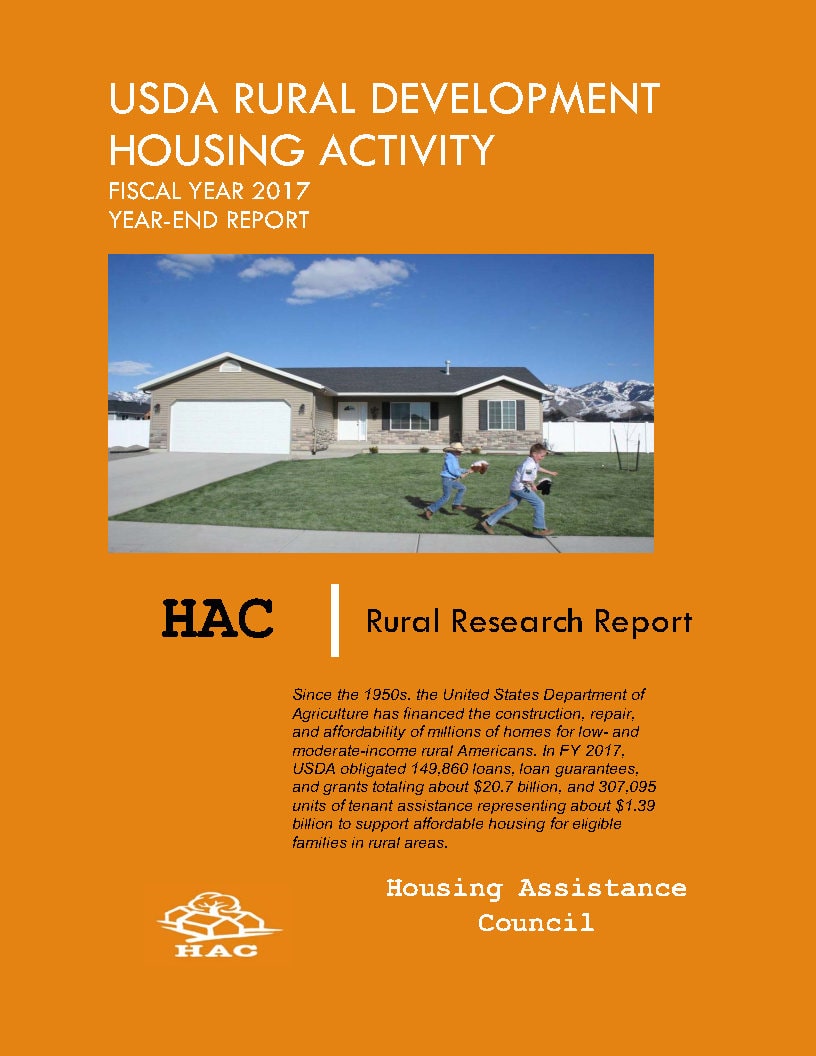 The Housing Assistance Council tabulated data using the USDA Finance Office obligation reports (USDA/Rural Development report code 205c, d and f) and data from the USDA Single Family Housing and Multifamily Housing Divisions in the National Office. The comprehensive report includes tables and maps showing obligation data by program and by State. The report also includes data by fiscal year for each of the programs since program inception.
The Housing Assistance Council tabulated data using the USDA Finance Office obligation reports (USDA/Rural Development report code 205c, d and f) and data from the USDA Single Family Housing and Multifamily Housing Divisions in the National Office. The comprehensive report includes tables and maps showing obligation data by program and by State. The report also includes data by fiscal year for each of the programs since program inception.
